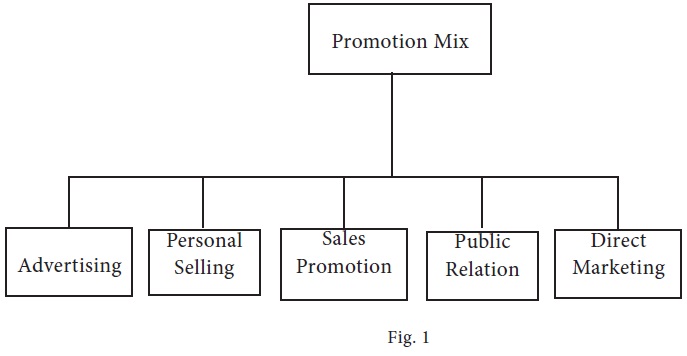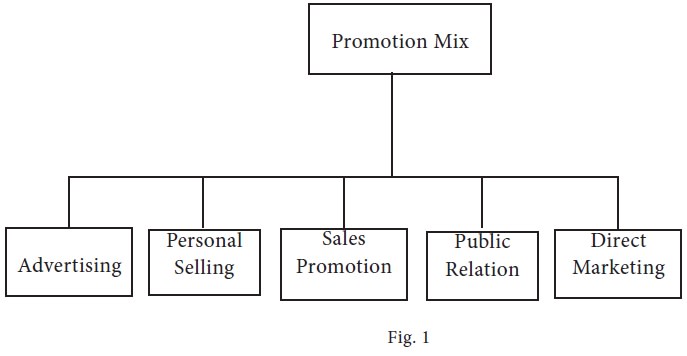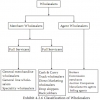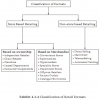MARKETING MANAGEMENT - PROMOTION DECISION
Promotion Mix
Posted On :

Promotion is a key part of marketing programme and is concerned with efficiently and effectively communicating the decisions of marketing strategy to target audiences.
Introduction
Promotion is a key part of marketing programme and is concerned with efficiently and effectively communicating the decisions of marketing strategy to target audiences. It is the marketing function concerned with persuasive communication of the marketing programme to target audience with the intent to facilitate exchange between the marketer and the customer, which may satisfy the objectives for both the customer and organization. Promotion is targeted to the target audiences. It is also goal oriented and the objective may be to create brand awareness, to educate the consumers, to create a positive image, to build preference. The ultimate goal is to sell the product or service to consumers who have a need of it.
The components of promotion mix
are as follows:
1. Advertising
2. Personal selling
3. Sales promotion
4. Publicity
5. Direct Marketing

In a time when customers are exposed daily to a nearly infinite amount of promotional messages, many marketers are discovering that advertising alone is not enough to move members of a target market to take action, such as getting them to try a new product. Instead, marketers have learned that to meet promotional method in conjunction with advertising.
Other marketers have found that certain characteristics of their target market (e.g., small but geographically dispersed) or characteristics of their [product (e.g., highly complex) make advertising a less attractive option. For these marketers better results may be obtained using other promotional approaches and may lead to directing all their promotional spending to non-advertising promotions.
Finally, the high cost of advertising may drive many to seek alternative, lower cost promotional techniques to meet their promotion goals.
The use of paid media by a seller to communicate persuasive information about its products, services, or organization—is a potent promotional tool. Advertising takes on many forms (national, regional, local, consumer, industrial, retail, product, brand, institutional, etc.)
Advertising decision-making consists of objectives setting, budget decision, message decision, media decision, and ad effectiveness evaluation. Advertisers should establish clear goals as to whether the advertising is supposed to inform, persuade, or remind buyers.
The factors to consider when setting the advertising budget are: stage in the product life cycle, market share, competition and clutter, needed frequency, and product substitutability.
The advertising budget can be established based on what is affordable, as a percentage budget of sales, based on competitors’ expenditures, or based on objectives and tasks, and based on more advanced decision models that are available.
The message decision calls for generating messages, evaluating and selecting between them, and executing them effectively and responsibly.
The media decision calls for defining the reach, frequency, and impact goals; choosing among major media types; selecting specific media vehicles; deciding on media timing; geographical allocation of media. Finally, campaign evaluation calls for evaluating the communication and sales effects of advertising, before, during, and after the advertising.
Sales promotion and public relations are two tools of growing importance in marketing planning. Sales promotion covers a wide variety of short-term incentive tools designed to stimulate consumer markets, the trade, and the organization’s own sales force. Sales promotion expenditures now exceed advertising expenditures and are growing at a faster rate.
Consumer promotion tools include samples, coupons, cash refund offers, price packs, premiums, prizes, patronage rewards, free trials, product warranties, tie-in promotions, and point-of-purchase displays and demonstrations.
Trade promotion tools include price-off, advertising and display allowances, free goods, push money, and specialty-advertising items. Business promotion tools include conventions, trade shows, contests, sweepstakes, and games. Sales promotion planning calls for establishing the sales promotion objectives, selecting the tools, developing, pretesting, and implementing the sales promotion program, and evaluating the results.
Marketing public relations (MPR) is another important communication/ promotion tool. Traditionally, it has been the least utilized tool but is now recognized for its ability in building awareness and preference in the marketplace, repositioning products, and defending them. Broadly, MPR is those activities that support the ultimate sale of a product or service. Some of the major marketing public relations tools are news, speeches, events, public service activities, written material, audio-visual material, corporate identity, and telephone information services. MPR planning involves establishing the MPR objectives, choosing the appropriate messages and vehicles, and evaluating the MPR results.
Promotion is a key part of marketing programme and is concerned with efficiently and effectively communicating the decisions of marketing strategy to target audiences. It is the marketing function concerned with persuasive communication of the marketing programme to target audience with the intent to facilitate exchange between the marketer and the customer, which may satisfy the objectives for both the customer and organization. Promotion is targeted to the target audiences. It is also goal oriented and the objective may be to create brand awareness, to educate the consumers, to create a positive image, to build preference. The ultimate goal is to sell the product or service to consumers who have a need of it.
1. Advertising
2. Personal selling
3. Sales promotion
4. Publicity
5. Direct Marketing

In a time when customers are exposed daily to a nearly infinite amount of promotional messages, many marketers are discovering that advertising alone is not enough to move members of a target market to take action, such as getting them to try a new product. Instead, marketers have learned that to meet promotional method in conjunction with advertising.
Other marketers have found that certain characteristics of their target market (e.g., small but geographically dispersed) or characteristics of their [product (e.g., highly complex) make advertising a less attractive option. For these marketers better results may be obtained using other promotional approaches and may lead to directing all their promotional spending to non-advertising promotions.
Finally, the high cost of advertising may drive many to seek alternative, lower cost promotional techniques to meet their promotion goals.
Advertising
The use of paid media by a seller to communicate persuasive information about its products, services, or organization—is a potent promotional tool. Advertising takes on many forms (national, regional, local, consumer, industrial, retail, product, brand, institutional, etc.)
Advertising decision-making consists of objectives setting, budget decision, message decision, media decision, and ad effectiveness evaluation. Advertisers should establish clear goals as to whether the advertising is supposed to inform, persuade, or remind buyers.
The factors to consider when setting the advertising budget are: stage in the product life cycle, market share, competition and clutter, needed frequency, and product substitutability.
The advertising budget can be established based on what is affordable, as a percentage budget of sales, based on competitors’ expenditures, or based on objectives and tasks, and based on more advanced decision models that are available.
The message decision calls for generating messages, evaluating and selecting between them, and executing them effectively and responsibly.
The media decision calls for defining the reach, frequency, and impact goals; choosing among major media types; selecting specific media vehicles; deciding on media timing; geographical allocation of media. Finally, campaign evaluation calls for evaluating the communication and sales effects of advertising, before, during, and after the advertising.
Sales promotion and public relations are two tools of growing importance in marketing planning. Sales promotion covers a wide variety of short-term incentive tools designed to stimulate consumer markets, the trade, and the organization’s own sales force. Sales promotion expenditures now exceed advertising expenditures and are growing at a faster rate.
Consumer promotion tools include samples, coupons, cash refund offers, price packs, premiums, prizes, patronage rewards, free trials, product warranties, tie-in promotions, and point-of-purchase displays and demonstrations.
Trade promotion tools include price-off, advertising and display allowances, free goods, push money, and specialty-advertising items. Business promotion tools include conventions, trade shows, contests, sweepstakes, and games. Sales promotion planning calls for establishing the sales promotion objectives, selecting the tools, developing, pretesting, and implementing the sales promotion program, and evaluating the results.
Marketing public relations (MPR) is another important communication/ promotion tool. Traditionally, it has been the least utilized tool but is now recognized for its ability in building awareness and preference in the marketplace, repositioning products, and defending them. Broadly, MPR is those activities that support the ultimate sale of a product or service. Some of the major marketing public relations tools are news, speeches, events, public service activities, written material, audio-visual material, corporate identity, and telephone information services. MPR planning involves establishing the MPR objectives, choosing the appropriate messages and vehicles, and evaluating the MPR results.
Tags : MARKETING MANAGEMENT - PROMOTION DECISION
Last 30 days 1084 views















